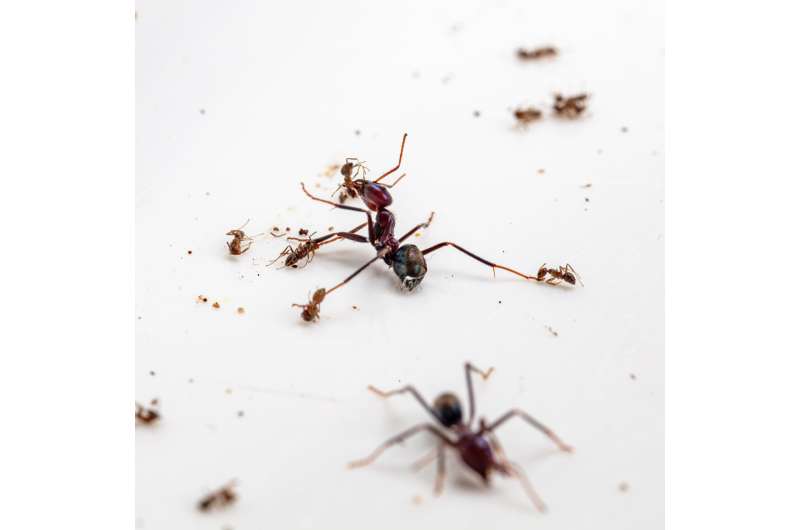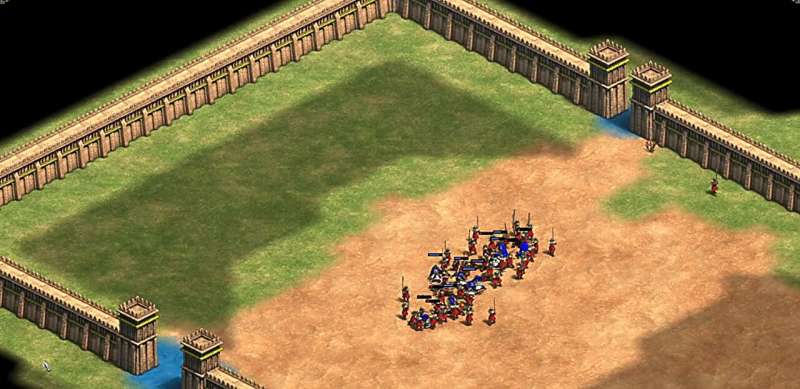This article has been reviewed according to Science X's editorial process and policies. Editors have highlighted the following attributes while ensuring the content's credibility:
fact-checked
peer-reviewed publication
trusted source
proofread
Ant wars: How native species can win the battle over invasive pests

New research using insight from virtual gaming and real-world ant battles shows how native insects can be given an upper hand against some aggressive introduced species, which could help guide non-native invasive ant management.
Dr. Samuel Lymbery, who undertook this work as a Forrest Prospect Fellow with The University of Western Australia and CSIRO, Australia's national science agency, used mathematical models on video game simulations, garnered from Age of Empires II, to illustrate how battlefield dynamics change warfare outcomes.
These concepts were then confirmed in the real-world by observing ant battles between Australian meat ants, a native species, and smaller Argentine ants, a notorious pest.
"What we found from virtual gaming and then real-life ant battles was that mortality in the small armies of Australian meat ants facing off with large armies of non-native Argentine ants was lower in complex arenas and higher in simple arenas," Dr. Lymbery said.
"So, just like for humans, and in computer games, the outcome of ant-wars depends on the nature of the battlefield."
Dr. Raphael Didham, Professor of Ecology in the School of Animal Biology at The University of Western Australia and CSIRO scientist, said social insects such as ants were one of the few species to engage in warfare on the same scale as humans.
"This is because the evolutionary future of the sterile worker ants who do the fighting is invested in the greater good of the colony," Professor Didham said.
"We used two ant species that clearly differed in their fighting prowess.
"Our first combatant was the Australian meat ant, Iridomyrmex purpureus. These large and beautiful ants are dominant in undisturbed bushland across regional Australia and construct gravelly nests.
"As their enemies, we selected the notoriously invasive Argentine ant, Linepithema humile. These aggressive ants have been introduced to Australia and are comparatively tiny, but live in extremely large, hyper-cooperative colonies.
"Meat ants always defeat Argentine ants in one-on-one duels because of their size advantage."

How modifying the battlefield can dictate victory
Dr. Bruce Webber, Principal Research Scientist at CSIRO, said the ant battlefield research could have practical application for non-native invasive ant management.
"Non-native invasive ants are some of the worst pests on the planet, costing the global economy tens of billions of dollars per year," Dr. Webber said.
"Invasive ants like Argentine ants are typically smaller and more numerous than native species, and are often more dominant in disturbed habitats.
"Disturbed environments are often simplified at ground level, with the removal of undergrowth and natural debris creating open battlefields.
"This research suggests that modifying areas where native and non-native ants co-occur, by adding natural debris or other such structures, may tip the balance in favor of our larger native species."
Dr. Lymbery said by modifying natural environments the native ants were given more opportunities to succeed.
"Warfare theory suggests that fewer, stronger soldiers will be more effective when battles are a series of one-on-one duels. But larger armies are more effective when they can surround their enemies and concentrate attacks," Dr. Lymbery said.
"Battlefield complexity can tip the balance in favor of one strategy over another.
"When fighting in tunnels, alleyways, or difficult terrain, it is harder for large armies to surround their opponents, so small forces of strong or savvy soldiers can sometimes succeed."
The paper "Complex battlefields favor strong soldiers over large armies in social animal warfare' was published in the Proceedings of the National Academy of Sciences.
More information: Samuel J. Lymbery et al, Complex battlefields favor strong soldiers over large armies in social animal warfare, Proceedings of the National Academy of Sciences (2023). DOI: 10.1073/pnas.2217973120
Journal information: Proceedings of the National Academy of Sciences
Provided by CSIRO

















